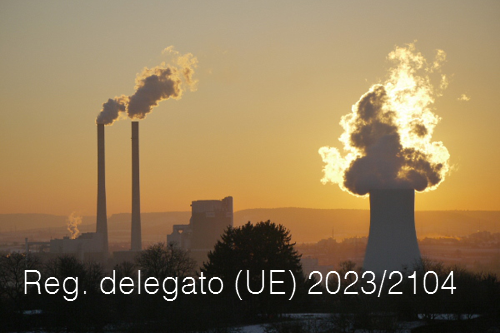Decreto 29 novembre 2000
Criteri per la predisposizione, da parte delle societa' e degli enti gestori dei servizi pubblici di trasporto o delle relative infrastrutture, dei piani degli interventi di co...
under the UNECE Convention on Long-range Transboundary Air Pollution (LRTAP)
This document is the annual EU(1) emission inventory report under the United Nations Economic Commission for Europe (UNECE) Convention on Long-range Transboundary Air Pollution (LRTAP Convention)
(UNECE, 1979). The report and its accompanying data constitute the official submission to the UNECE secretariat by the European Commission on behalf of the EU as a Party to the UNECE Executive Secretary
(Box ES.1). The EEA compiled the report in cooperation with the EU Member States, the United Kingdom and the European Commission.
The LRTAP Convention obliges and invites Parties to report emission data for numerous air pollutants:
• main pollutants: nitrogen oxides (NOX), non‑methane volatile organic compounds (NMVOCs), sulphur oxides (SOX), ammonia (NH3) and carbon monoxide (CO);
• particulate matter (PM) emitted directly to the air (primary PM):
– PM with a diameter of 2.5 μm or less (PM2.5; also called fine particulate matter);
– PM with a diameter of 10 μm or less (PM10);
– black carbon (BC), the most strongly light‑absorbing component of PM;
• total suspended particulates (TSPs);
• priority heavy metals (HMs): lead (Pb), cadmium (Cd) and mercury (Hg);
• additional HMs: arsenic (As), chromium (Cr), copper (Cu), nickel (Ni), selenium (Se) and zinc (Zn);
• persistent organic pollutants (POPs): polychlorinated dibenzodioxins/dibenzofurans (PCDD/Fs), polycyclic aromatic hydrocarbons (PAHs), hexachlorobenzene (HCB) and polychlorinated biphenyls (PCBs);
•additional reporting of the individual PAHs, benzo(a) pyrene (B(a)P), benzo(b)fluoranthene (B(b)F), benzo(k)fluoranthene (B(k)F) and indeno(1,2,3-cd) pyrene (IP), and the sum of all four.
These pollutants harm human health and the environment. Certain species also contribute to the formation of ground-level ozone (O3) and secondary PM in the atmosphere. Some pollutants have both an indirect and a direct effect on the sunlight absorbed by the Earth and reflected back to space (radiative forcing) and hence on climate (EEA, 2014, 2015, 2019a).
This report addresses:
• the institutional arrangements and preparation processes behind the EU's emission inventory, methods and data sources, reporting, key category analyses, information on quality assurance and control, general uncertainty evaluation, and information on completeness and underestimations (Chapter 1);
• information on approved adjustments and adjustment applications under the Gothenburg Protocol (Chapter 2);
• emission trends for the EU as a whole and for individual EU Member States, and the contribution of key categories to total emissions (Chapter 3);
• sectoral analyses and emission trends for key pollutants (Chapter 4);
• information on recalculations, as well as planned and implemented improvements (Chapter 5);
• brief information on the status of the (not mandatory) reporting of the condensable component of PM10 and PM2.5 (Section 1.5.5).
Emission data presented in this report are presented
(1) The United Kingdom left the EU on February 1, 2020, but applies EU law until the end of the transition period, December 31, 2020. References to 'EU Member States' and 'EU-28' made in this report in relation to information to the period 1990-2018, therefore refers to the air pollutant emission totals of the EU-27 plus the emissions of the United Kingdom, i.e. the EU-28.
...add more in attachment
EEA 2020
Collegati
Criteri per la predisposizione, da parte delle societa' e degli enti gestori dei servizi pubblici di trasporto o delle relative infrastrutture, dei piani degli interventi di co...

ID 20505 | 04.10.2023
Regolamento delegato (UE) 2023/2104 della Commissione del 4 luglio 2023 che modifica il regolamento delegato (UE) 2015/2402 per quanto riguarda ...

La XIV edizione del “Rapporto Rifiuti Speciali” dell’ISPRA fornisce un quadro completo di informazioni sui rifiuti definiti “speciali”, ovvero tutti i rifiuti ...
Testata editoriale iscritta al n. 22/2024 del registro periodici della cancelleria del Tribunale di Perugia in data 19.11.2024